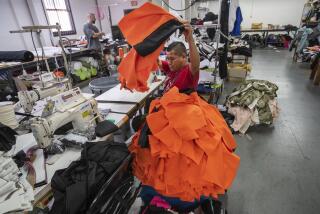Factory Orders Up 1% in Month : Durable Goods Demand Slips for Third Month
- Share via
WASHINGTON — Orders to U.S. factories rose a modest 1% in November even though demand for durable goods fell for the third consecutive month, raising concern among economists about the strength of the economy heading into the new year.
The Commerce Department said Thursday that factory orders totaled $197.4 billion in November, a $2-billion gain over the October level and the first increase in three months.
In a second report Thursday, the department said construction spending rose 0.5% in November to an annual rate of $348.2 billion.
All of the strength in factory orders came in demand for non-durable goods, which shot up by 2.5%, the biggest increase in this category in five years. Demand for durable goods--items such as cars and appliances that are expected to last three or more years--fell by 0.3%. This setback followed even steeper declines in September and October of 0.9% and 2%, respectively.
Because orders for non-durable goods are filled as quickly as they are placed, they provide little indication of future production. However, analysts said the string of declines in durable-goods orders was particularly troubling because it could be signaling future plant shutdowns and job layoffs.
“We have been forecasting a slowdown continuing into the first half of 1986, and this is evidence that it is occurring,” said David Berson, an economist with the forecasting firm of Wharton Econometrics in Philadelphia. “This shows that U.S. firms are still finding the trade situation particularly difficult.”
No Relief Yet
U.S. manufacturers have been battered for more than a year by a flood of foreign goods made cheaper by the high overseas value of the dollar. While the dollar has been declining, analysts said the drop has not been steep enough or gone on long enough to provide U.S. producers with relief.
Berson said economic growth for the October-December period was likely to dip to 2.8% from the 3% rate in the third quarter. He said economic growth would fall even further--to 2%--in the first three months of this year before beginning to rise again as the effects of a lower dollar, falling interest rates and lower oil prices begin to revive activity.
Michael Evans, head of Evans Economics in Washington, said a string of weaker reports had caused him to revise his estimate of fourth-quarter growth down to 3%. The government--in a “flash” estimate before the quarter was over--said the gross national product was expanding at a 3.2% rate in the fourth quarter, but that estimate is subject to major revisions.
Unexpected Weakness
The moderate gain in construction spending for November followed downward revisions in earlier months. Construction spending in October had originally been estimated as growing by 0.4%, but this was revised to a slight 0.1% gain.
Analysts said these downward revisions in construction represented unexpected weakness in what has been considered one of the strongest sectors of the economy.
The Reagan Administration also is predicting sharply faster growth this year of 4%, compared to the 2.4% projected for 1985. But many private analysts believe that growth in 1986 will be much like last year.
The overall gain in factory orders in November was the largest since a 1.5% advance in August. Orders had declined by 1% in October and 0.7% in September.
The sharp jump in orders for non-durable goods came from heavy demand for food and petroleum products.
The 0.3% drop in orders for durable goods represented a revision from an advance report last week that showed a 0.9% increase in durable-goods orders.
Defense Equipment Orders
The strength in this area came from a sharp 12.7% rise in orders for defense equipment that followed big declines of 23.8% in October and 21.1% in September.
The key category of non-defense capital goods showed a decline of 3.1% following a 7.3% drop in October. However, analysts said the November decline overstated the weakness in this area because it was concentrated in orders for civilian aircraft. This category is closely watched for indications of business plans to expand and modernize.
Orders for transportation equipment were down 7.1% as declines in orders for aircraft and shipbuilding more than offset increases in orders for motor vehicles.
Orders for primary metals dropped 2.8% in November following a 5.3% October increase.
Shipments of manufactured goods rose 1.6% to $200.4 billion in November, the third increase in four months and the largest gain since a 1.6% advance in December, 1984.
More to Read
Inside the business of entertainment
The Wide Shot brings you news, analysis and insights on everything from streaming wars to production — and what it all means for the future.
You may occasionally receive promotional content from the Los Angeles Times.










